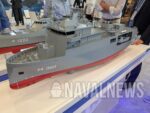Scaled Composites has initiated flight envelope expansion testing of its Model 437 Vanguard unmanned aerial vehicle (UAV), an experimental high-speed platform developed in partnership with Kratos Defense. The program marks a significant step toward validating next-generation unmanned combat air vehicle (UCAV) concepts tailored for intelligence, surveillance, reconnaissance (ISR), and potential strike missions.
Vanguard Origins: A Collaboration Between Scaled Composites and Kratos
The Model 437 Vanguard is the latest in a lineage of experimental UAVs from Scaled Composites—a Northrop Grumman subsidiary known for its rapid prototyping and unconventional designs. The aircraft was first revealed publicly in April 2024 when it appeared on the Mojave Air & Space Port flight line. It is believed to be part of a joint development effort with Kratos Defense & Security Solutions, which has extensive experience with low-cost attritable UAVs such as the XQ-58A Valkyrie and UTAP-22 Mako.
While neither company has officially disclosed program sponsorship or end-user intent, multiple defense analysts suggest that the platform is aligned with U.S. Air Force Research Laboratory (AFRL) initiatives focused on collaborative combat aircraft (CCA) and autonomous teaming. The design appears optimized for high-subsonic or transonic performance with long endurance—traits consistent with future loyal wingman or stand-in ISR roles.
Flight Test Campaign at Mojave
The current test campaign centers on expanding the flight envelope—validating aerodynamic stability and control across various speeds and altitudes. According to imagery published by The Aviationist and corroborated via satellite imagery from Planet Labs dated September 2025, at least three test sorties have occurred since August from Mojave Air & Space Port (MHV), California.
The aircraft features a sleek blended-wing-body configuration with twin vertical stabilizers canted outward—suggesting emphasis on radar cross-section reduction. It uses conventional landing gear rather than rocket-assisted takeoff or bungee launch systems employed by earlier Kratos drones. This indicates greater emphasis on reusability or integration into traditional airbase infrastructure.
Notably absent are visible air data probes or pitot tubes during early flights—likely replaced by flush-mounted sensors or synthetic air data systems common in stealthy designs. Observers also noted that the aircraft appeared to fly autonomously without chase plane escort during at least one sortie—a possible indication of advanced onboard autonomy or pre-programmed flight profiles.
Design Characteristics Point to High-Speed ISR Role
Although full specifications remain undisclosed, visual analysis suggests the Model 437 is approximately 8–10 meters in length with a wingspan near 7 meters—placing it between the XQ-58A Valkyrie and MQ-28 Ghost Bat in size class. Its engine intake is mounted dorsally behind the cockpit area—a design choice often used to reduce infrared signature from ground-based threats while preserving airflow at high angles of attack.
The configuration lacks external hardpoints or visible weapon bays; however, internal payload capacity remains plausible given its fuselage volume. This supports theories that early variants are focused primarily on ISR roles—possibly carrying EO/IR sensors or electronic support measures (ESM) payloads internally. Future iterations may incorporate modular bays for munitions such as GBU-39 SDBs or air-to-air missiles depending on mission evolution.
The use of composite materials throughout the airframe aligns with Scaled’s design philosophy and enables weight savings critical for long-endurance missions without sacrificing structural integrity under higher dynamic pressures associated with envelope testing.
Strategic Context: Filling Capability Gaps in Future Air Combat
The emergence of platforms like Vanguard reflects growing urgency within U.S. defense circles to field affordable but capable unmanned systems that can operate inside contested environments alongside manned fighters like F-35s and B-21 bombers. The USAF’s CCA program under Next Generation Air Dominance (NGAD) aims to deploy such drones by late this decade—with multiple vendors competing under classified contracts.
- XQ-58A Valkyrie: Already tested extensively by AFRL; designed for strike/ISR roles at low cost (~$4M per unit).
- Boeing MQ-28 Ghost Bat: Developed for Australia’s Loyal Wingman program; larger payload capacity but higher cost (~$10–15M).
- Sierra Technical Services’ “5th Gen Aerial Target”: Also tested at Mojave; shares some design lineage with Vanguard but optimized as threat emulator rather than operational UCAV.
If successful, Vanguard could join this ecosystem as a mid-tier option emphasizing speed over stealth while retaining modularity for varied mission sets—from penetrating ISR to jamming decoys or kinetic strike support.
What Comes Next?
No official roadmap has been released regarding production timelines or operational transition pathways for Model 437. However, if envelope expansion proceeds smoothly through late 2025 into early 2026—as expected—the platform may enter more advanced mission system integration tests thereafter.
This phase would likely involve sensor payload testing (EO/IR turrets, SIGINT packages), datalink validation (Link-16/MIDS-JTRS compatibility), GPS-denied navigation trials using terrain contour matching (TERCOM) or visual odometry methods—all critical enablers for autonomous operations in denied environments like Eastern Europe or Indo-Pacific A2/AD zones.
An eventual demonstration under AFRL’s Skyborg Autonomy Core System—or integration into Red Flag exercises—would signal readiness for operational experimentation alongside manned assets such as F-22 Raptors or B-21 Raiders within USAF’s evolving kill web construct.
Conclusion: A Promising Contender in Emerging UCAV Landscape
The Model 437 Vanguard represents a promising addition to America’s growing portfolio of unmanned combat air vehicles tailored for near-peer conflict scenarios. With its clean-sheet design optimized for speed and survivability—and backed by two industry leaders in rapid prototyping—it may offer an agile path forward amid rising demand for scalable autonomy across domains.
If adopted into service—or even as an experimental surrogate—it could help shape doctrine around manned-unmanned teaming concepts central to NGAD-era warfare doctrine while informing future acquisition strategies focused on cost-effective mass under budgetary constraints.









